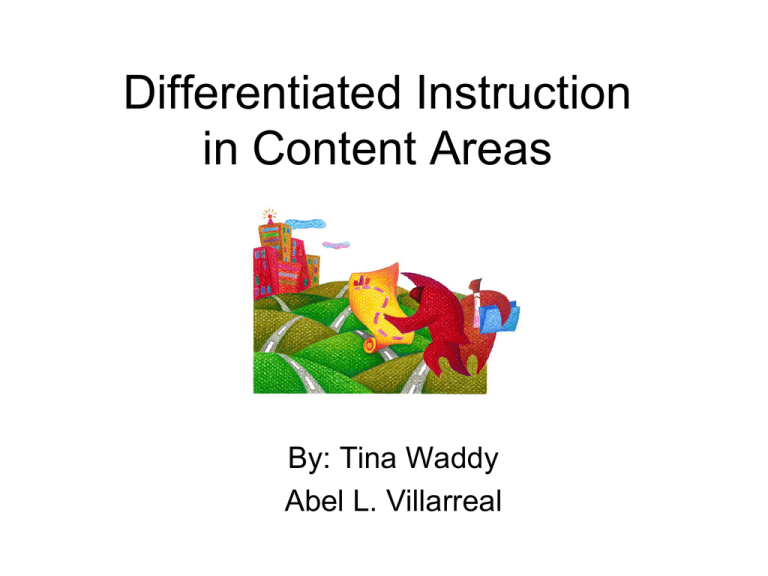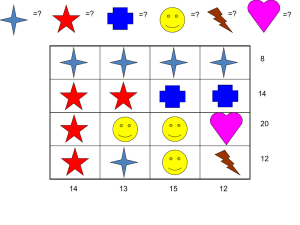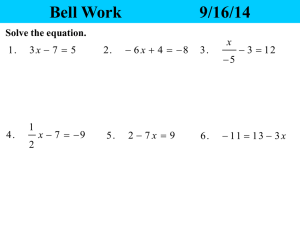PowerPoint Presentation - Austin Community College
advertisement

Differentiated Instruction in Content Areas By: Tina Waddy Abel L. Villarreal A Growing Tide of Failure • From the 1990’s to the present, schools have had to cope with an epidemic of incoming 9th graders that are ill prepared for high school. • On April 30, 2009, the Texas Education Agency reported that 21% of 317,830 students (about 66,744) failed the 8th grade Math TAKS examination. • Over 90% of these failures will be promoted to 9th grade anyway. How will math teachers respond? What Is It? • Differentiated instruction is an instructional approach that encompasses several learning strategies simultaneously. • This technique matches student learning characteristics to a teaching modality (tactile, kinesthetic, or audio). • Teachers use “differentiated instruction” to bridge the widening gap. • Once a solid learning connection is made, students are much more engaged and successful with the curriculum. Implementation Teachers can differentiate… – Content – Process – Student Products Differentiated Content Change the material, the order in which it is presented, the source, and the quantity of information being learned by a student. Example Objective: Solve 3-step linear equations. – Student A reviews 1-step, 2-step equations and then move on to learn some 3step equations. – Student B will learn 3-step equations and then work in a small group to solve TAKS level extensions of 3-step equations. Differentiated Process • Change the way students access the assigned information. Example – Student A will access a 5 minute PowerPoint presentation and learn to solve 3-step equations. – Student B will access a math website and do the online tutorial to learn to how solve 3-step linear equations. Differentiated Products Change the way students demonstrate what they’ve learned. Example Objective – Students will solve 3step linear equations. – Student A will solve a set of computer generated problems. – Student B will solve a teacher created set of problems and then solve a series of real world linear equations with a graphing calculator. Responding to Students Needs • Teachers differentiate responses to student needs. Student needs include: – Reading Ability. – Confidence level. – Competency level in Mathematics. – Extent of background Knowledge. – English language proficiency. – Learning disabilities. Differentiation Variables Instructional Choice Variables Complexity of the Content Students needs and abilities and effect of past math experiences. Processes and Techniques used to Communicate Content Students learning preferences and reading comprehension level. Student Products and Assessments that Demonstrate Learning Student interest, ability, and experience. Implementation Before you Teach… • Use diagnostic instruments to assess skills level. • Study previous student data (TAKS scores, report cards, etc.) to determine learning patterns. • Determine student interest. • Identify student learning styles and environmental preferences. Diagnostic Assessments • Can be informal or formal. • Determine student readiness level. Examples • Pre-tests. • Survey Background. Knowledge. • K-W-L Charts. • Student self assessments. • TAKS scores. • Report cards. Student Interest • Discover what students like and don’t like. Examples: • Interest inventories. • Include students in the planning process. • Incorporate student interests in key projects and explorations. Learning Style • Find out the type of learners your students are (tactile, kinesthetic, audio) Example: • Learning Style Inventories (LSI) • Observe student activities and behavior in school – Look for environmental factors that inhibit student learning. Strategies Learning Style Auditory, Visual, and Kinesthetic Learners Strategy •Demonstrations •On-site field studies •Audio-visual Presentations •Small-group discussion Mix of Learning Styles •Problem solving activities •Research, hands-on Experimentation •Off Campus Field Trips What Does Differentiated Instruction Look Like? • • • • • • • Tiered Assignments. Compacting. Interest Centers or Interest Groups. Flexible Grouping. Learning Contracts. Choice Boards. Orbital Studies. Tiered Assignments • Focus of differentiation is on student readiness. • Designed to instruct students on essential skills at different levels of complexity and abstractness. Example: Math - Tier III students start with prerequisite skills and work up to target objective. – Sample A - Students learns to evaluate expressions. – Sample B – Students learn to solve ratios and proportions. – Sample C – Students learn to solve linear equations. Sample “A” Math Sample B Sample C Tiered Assignments • Focus of differentiation is on student readiness. • Designed to instruct students on essential skills at different levels of complexity and abstractness. Example: Science Students study the characteristics of living vs. non-living things. – Tier III students are guided in identifying things from both groups. – Tier I & II students work in groups to brainstorm examples of non-living and living things. Compacting • Focus of differentiation is on student readiness. • Adjust instruction to account for student mastery of certain objectives. • Compacting process includes assessment, and planning. Examples Math Science Objective: Solve 3-step linear equations. – Students who has already mastered the concept will solve 4 and 5-step equations. – Students are given more instruction on 1-step, 2step, and 3-step equations. Objective: Understand the steps of photosynthesis. – Students who already know the process are given a lab assignment. – Students are given more instruction on the concept. Interest Centers / Groups • Focus of differentiation is on student readiness and interest. • Interest centers are used with younger students. • Interest groups are used with older students. • Learning experience is directed toward a specific learner interest. • Student choice can impact motivation in a positive way. Example: • Interest Centers – Can focus on specific topics like percents, fractions, proportions. • Interest Groups – Can focus on small groups that are planning and building scale models, or making predictions on voting patterns. Flexible Grouping • Focus of differentiation is on student readiness, interest, and learning style. • Students work in different groups. • Group placement is determined by either readiness, interest and/or learning style. • Groups can be assigned by teacher, or student choice can be given. Example: Students take on a specific role in groups to explore the layout of a landscaping project. – A student who is a strong artist can draw a sketch. – A student who enjoys public speaking might present group’s model. – A student strong in computation can estimate the cost of materials. – A student strong in organizing skills can formulate a timetable for the landscaping project completion. Learning Contracts • Focus of differentiation is on student readiness, and learning profile. • Agreement between the teacher and the student. • Teacher determines the necessary skills to be learned, and the required components of the assignment. • Student identifies methods for completing the assignment. Example: Student wants to improve grades to play sports. – Teacher guides student through the process of developing a plan. – Student decides method for completing the assignment. – Teacher and students set goals. Choice Boards • Focus of differentiation is on student readiness, interest, and learning profile. • Organizers contain a variety of activities. • Students are allowed to choose an activity. • Activities can be focused around several different skills. Examples Math Objective: Students must complete two of the following activities to learn about 3-step equations. – Make a poster that has a fraction, decimal, and integer 3-step equations. – Produce a short video outlining a procedure for solving any 3-step equation. – Find 4 websites that demonstrate how 3-step equations are solved. Science Objective: Students must complete two of the following activities to learn about density. – Using a water table to explore properties of various objects, – Reading a chapter in their textbook about density, – Watching a video about density. Orbital Studies • Focus of differentiation is on student readiness, interest, and learning profile. • Concept is based on theme. • Students are given choices. • Teacher provides guidance and coaching. Examples Math Science Objective: Students are learning Objective: Students are learning about the solar system. They are allowed to choose from the following topics. about solving linear equations. They are allowed to choose from the following topics. – Graph different equations and compare slopes. – Convert data tables into equations and graphs. – Convert proportions into linear equations. – Satellites – Habitable Planets Materials • Students should explore concepts using a variety of resources. Resources: – Textbooks – Graphic Images – Audio-visual Representations – Internet searches – Guest speakers Complex Instruction • Create open-ended questions and tasks for instruction. • Open-ended questions push students to think outside the box. • Teach students to think all the way around a topic. • Provide scaffolding for support. Role Play • Create activities that stimulate learning and directly appeal to student interest. • Students enjoy watching peers role play, or debate about a current science or social studies topic. • Have students create computer simulations. • More common in the social sciences and humanities. Take It Slow • Teachers can’t differentiate 100% of the content. • Be realistic. Start differentiating a little at a time. • Creativity comes in waves, not steady streams. • Access information and examples from the Internet. • Ask other teachers for help and advice. Activity Look over this PowerPoint and… A. Carefully outline and summarize the important points. B. Look over the “DAM-IT” lesson plan example and template. “Differentiate” a lesson plan for any topic or lesson you like. Resources http://teachingtoday.glencoe.com/howtoarticles/differentiating-science-instruction Hall, T., Strangman, N., & Meyer, A. (2003). Differentiated instruction and implications for UDL implementation. National Center on Accessing the General Curriculum. Retrieved July 9, 2004 from: http://www.k8accesscenter.org/training_resources/udl/diffinstruction.asp Tomlinson , C.A. (1999). How to differentiate instruction in mixed-ability classrooms. Alexandria , VA : ASCD. http://www.cast.org/ncac/index.cfm?i=2876 – This site contains an article by Tracy Hall at the National Center for Accessing the General Curriculum. The article discusses differentiation as it applies to the general education classroom. http://members.shaw.ca/priscillatheroux/differentiatingstrategies.html - The Enhancing Learning with Technology site provides explanations for various differentiation strategies. http://www.mcps.k12.md.us/curriculum/science/instr/differstrategies.htm - A Web site that lists instructional strategies and techniques that teachers can use to differentiate in the science classroom.




